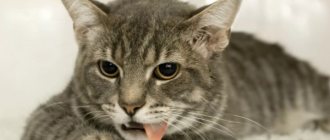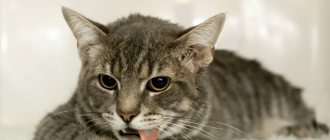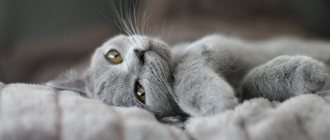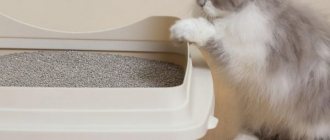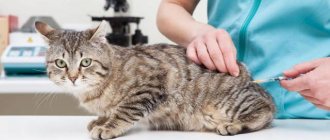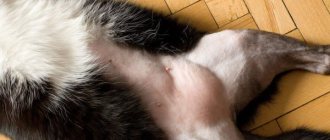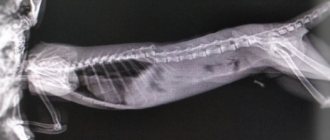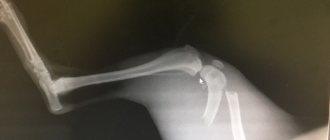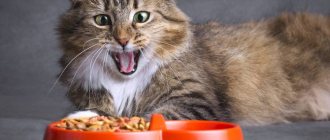Muscle cramps in a cat are not an independent disease, but only indicate the presence of a serious pathology in the body. They are accompanied by severe pain and a sharp contraction of certain muscle groups. During such spasms, the animal cannot move, screams heart-rendingly and shows signs of aggression. Even a single short-term attack should be reported to a veterinary specialist, trying to describe its course and nature in small details.
Symptoms of seizures
All types of seizures in cats have the following general signs:
- strong stretching of limbs;
- stiffness and muscle deformation;
- unnatural body posture;
- heart-rending cry of pain and fear;
- dilated pupils;
- rapid breathing;
- flattened ears.
In some cases, the animal is afraid to move, as the pain intensifies when moving. Sometimes, on the contrary, it tries to rise to its paws to no avail. When the hind limbs spasm, the cat falls on its side or remains in a standing position, but alternately stretches its paws back, as if stretching.
When the pharynx spasms, the animal drools or foams at the mouth. Involuntary urination and vomiting may occur. Other signs are classified depending on the type of seizure.
Types of seizures
Based on the nature of the seizures, an experienced specialist can make a preliminary diagnosis. To facilitate this task, there is a classification of muscle spasms.
- Tonic spasms are manifested by excessive muscle contraction lasting a short period of time.
- Clonic seizures are characterized by alternating muscle tension and relaxation, most often involving rhythmic twitching of the hind legs. Such contractions indicate damage to the nervous system and brain.
- Tonic-clonic seizures are characteristic of epileptic seizures, poisoning and some other dangerous pathologies.
Important! If you notice that your cat is having a seizure, you need to remain calm and try to remember all the details of the attack. This may seem immoral, but if there is another person next to the owner providing first aid to the animal, then you should ask him to take a video of what is happening to show the veterinarian. It should be understood that when it comes to saving the life of a pet, sentimentality is not appropriate.
Seizures caused by brain damage
Clinical signs of encephalitis caused by different etiologies are similar. But owners should know the characteristics of the most common and dangerous diseases that cause brain damage, as well as the ways of their spread. This will help you pay attention to alarming symptoms in time, and in some cases, prevent infection.
Tick-borne encephalitis
If you find a tick on your pet’s body, you must carefully remove it using vegetable oil and a thick thread, treat the wound with a disinfectant and observe the animal for two weeks. You should contact your veterinarian if the following clinical signs appear:
- serous discharge from the nasal cavity and eyes;
- fever;
- lethargy, apathy;
- impaired coordination of movements;
- a sharp decrease in appetite;
- vomiting and diarrhea;
- inappropriate behavior.
Seizures caused by metabolic disorders
Pathologies of organs and endocrine glands in cats can also cause seizures. This is due to a violation of the metabolism of individual elements, inflammation and intoxication phenomena caused by untimely removal of decay products from the body.
Eclampsia
A decrease in the concentration of calcium in the blood serum to a critical level in pregnant and lactating cats is manifested by changes in behavioral reactions and frequent painful convulsions. First, the hind legs and facial muscles twitch. Gradually, other parts of the body are involved in the process, attacks become more frequent and intensified.
The cat falls over on its side, makes uncoordinated movements, and the state of apathy is replaced by sudden excitement. Severe forms end in coma and death.
Hypoglycemia
A sharp drop in blood sugar can cause clonic-tonic seizures, similar to epileptic seizures. This usually occurs after a large dose of insulin is injected for diabetes.
In this case, the glucose level should be immediately stabilized by oral administration of a sweet solution.
Important! In a clinical setting, to relieve an attack of hypoglycemia, doctors administer a glucose solution intravenously after accurately determining the animal’s sugar level. But you should not do this at home without performing a rapid analysis, since in case of an overdose, a hyperglycemic coma may develop.
Kidney failure
The reasons for the development of this complex of symptoms may be autoimmune diseases, inflammation, infectious lesions, and poisoning. An attack can develop after anesthesia administered without observing the dosage.
Due to impaired elimination of toxins during renal failure in cats, symptoms of central nervous system damage rapidly increase, expressed in convulsions and paralysis. And when the disease passes the terminal stage, destructive processes begin in the brain, leading to the death of the animal.
Old age
Seizures in an old cat may be a consequence of a chronic form of pathology. It can form as a result of improper feeding, infections, poisoning or urolithiasis that developed after sterilization. The degeneration of kidney tissue in chronic renal failure is considered irreversible, therefore modern veterinary medicine does not have methods for treating the disease.
Causes of convulsions
All types of muscle contractions indicate that there are many factors that provoke symptoms.
To make it easier to make a diagnosis and carry out targeted treatment, the predetermining causes are divided into groups:
factors associated with brain dysfunction;- reasons that led to disruptions in the metabolic processes of the cat’s body;
- intoxication.
These are based groups that include entire lists of diseases in which sudden convulsions and seizures are possible.
Each cause of muscle contractions should be considered in detail so that you know what you have to face.
Poisoning
When cats swallow toxic substances, the digestive organs are initially affected, and after the toxins are absorbed into the blood, the structural elements of the nervous system are destroyed. This is accompanied by clonic-tonic convulsions, vomiting, diarrhea, internal and external hemorrhages, and behavioral disturbances. Intoxication of the body, accompanied by convulsions, can also occur as a result of the accumulation of a large number of helminths in the intestines, releasing toxic products of their vital activity. This can be easily prevented by timely deworming of the animal.
Important! Many owners, not knowing what to do if their pet is poisoned, try to induce vomiting. But if an animal experiences convulsions, then it is strictly forbidden to do this, since there is a risk of vomit entering the respiratory tract, which will lead to suffocation and death.
Preventive measures
Prevention will help you avoid problems related to your pet’s health:
- diet with the selection of balanced feeds;
immunization and deworming of the animal;- regular treatment against parasites;
- timely treatment of infectious diseases.
Preventive visits to the veterinarian 1-2 times a year will help to promptly identify and eliminate diseases of internal organs and systems.
Epileptic seizures
A distinctive feature of epileptic attacks is the fact that the animal is unconscious . With all other types of seizures, consciousness is preserved. Clinicians distinguish 3 phases of the disease, the most severe of which is the seizure phase.
It is characterized by:
- clonic-tonic convulsions;
- profuse salivation and foam from the mouth;
- wheezing and shortness of breath;
- involuntary bowel movements and urination;
- tachycardia.
As the attack subsides, the animal regains consciousness, but for several minutes does not recognize the owners and does not orient itself in a familiar environment. After returning to normal, cats experience increased thirst and hunger.
Cramps during sleep
Inexperienced owners often contact the clinic after noticing that in their sleep their pet makes movements similar to convulsions, during which the cat:
- eyelids and lips tremble;
- front or hind legs twitch;
- the tail is shaking.
Most often, such signs indicate a phase of REM sleep , after which the pet calmly continues to rest further. But if, after convulsive twitching, he jumps up sharply, loses orientation in space, makes loud sounds and looks scared, then this may indicate the development of a pathological process in the body.
What can nocturnal epilepsy be confused with?
Sleep disorders similar to sleep epilepsy:
- Parasomnias (somnambulism, night terrors, waking up with confusion).
- Rhythmic motor acts during sleep (benign sleep myoclonus, involuntary movements of the limbs, bruxism = teeth grinding).
- Enuresis (bedwetting).
- Disturbance of the breathing rhythm during sleep (sleep apnea, including physiological apnea in children, obstructive apnea in adults).
- Movements during rapid eye movement sleep.
- Automatisms in sleep (swinging, yactation).
- Nocturnal “paralysis” (or nocturnal “intoxication”).
Death throes
In most cases, cats experience agony before death, preceded by a decrease in heart rate and respiratory movements. This leads to hypoxia, which provokes nervous phenomena such as convulsions. Tonic contraction and tremor of muscles can also be caused by insufficient oxygen supply to them and the death of nerve endings.
Some owners believe that if the cat does not make loud meowing sounds during the agony stage, then it is not in pain. But that's not true. Silence can be caused by paralysis of the pharynx or the individual characteristics of the animal.
The presence of pain syndrome is indicated by:
- dilated pupils;
- intermittent breathing;
- body immobility;
- complete detachment from the environment.
Important! If the pre-death atonal period lasts for many hours, then it is advisable to end the pet’s suffering through euthanasia. Despite the difficulty of making such a decision, it will be a manifestation of true humanity towards your pet. It is worth clearly understanding that pity in this case is a manifestation of weakness and selfishness, and not love and compassion!!!
Treatment at the Energy of Health clinic
Doctors at the Energy of Health clinic will always come to the aid of patients with intercostal neuralgia. We offer each client:
- a full examination with consultations with specialists for an accurate diagnosis;
- individual selection of treatment regimen;
- services of a qualified chiropractor;
- own exercise therapy room for the most effective and safe exercises;
- modern methods of physiotherapy;
- massotherapy;
- drug blockades for severe pain syndrome.
Regular observation by a neurologist after the acute period of the disease has subsided will help prevent recurrent attacks.
Other factors that trigger seizures in cats
Sometimes seizures can manifest themselves as complications after improper medical procedures or hygiene procedures.
After operation
Muscle spasms after surgery may indicate:
- incorrect choice of anesthesia;
- individual intolerance to the drug;
- errors in surgical intervention.
After anesthesia injection
In case of an overdose or an allergic reaction to the administration of anesthesia, hypoxia may develop, characterized by:
- cyanosis of mucous membranes;
- convulsions;
- hypotension;
- bradycardia;
- dilation of the pupils.
After stress
Muscle contractions in cats can be a response to stress. Although rare, they occur after bathing, if the animal is painfully exposed to water procedures, transportation, severe fright, or the appearance of another animal in the house.
Severe stress in cats includes the period of sexual heat. The absence of a male during estrus can cause seizures, anorexia, aggressive behavior and even mental disorders.
First aid for seizures
If a pet has an attack, it is very important not to get confused and provide competent first aid.
- Transfer the animal to a flat surface, having previously covered it with a disposable diaper or piece of cloth.
- You cannot forcefully hold a cat in a certain position or try to open its jaws.
- Do not give anticonvulsants or painkillers orally.
- You can give the animal a massage, which consists of lightly stroking the cramped muscles.
After the seizure ends, you should take your pet in your arms, talk to him, calm him down, cover him with a warm blanket, offer water and food.
Important! Independent use of anticonvulsants is unacceptable. The appropriateness of their use and dosage should only be determined by a doctor.
Even a single attack of seizures must be reported to a veterinarian, who will conduct a full examination and determine the cause of its occurrence. In this case, you should talk in detail about its clinical manifestations, previous illnesses and injuries, changes in food or living conditions.
Rules for taking anticonvulsants in veterinary medicine
When a veterinarian prescribes anticonvulsants, you must adhere to the established rules:
- The dose and schedule for taking the medicine must be strictly established; chaotic use is not allowed.
- You should not spontaneously stop treating your cat - this can lead to stronger seizures.
- If the drug runs out, you need to worry about buying a new package in advance. If the medicine is given on a prescription, you must notify your veterinarian.
- The product must be stored in a safe place, out of reach of animals or children.
- You need to consult a veterinarian about compatibility with other drugs, if there is a need for supplements.
